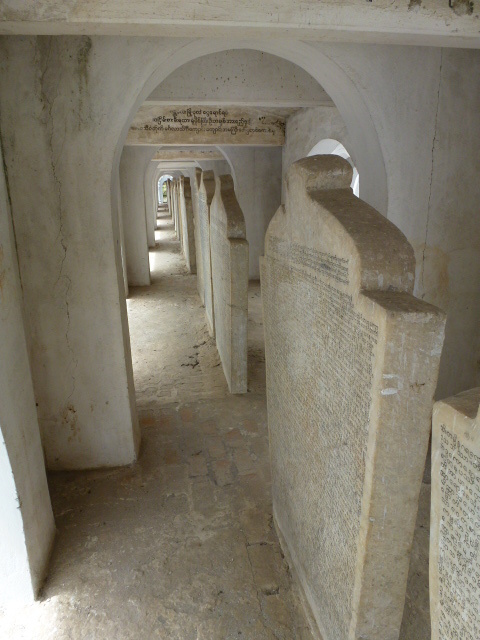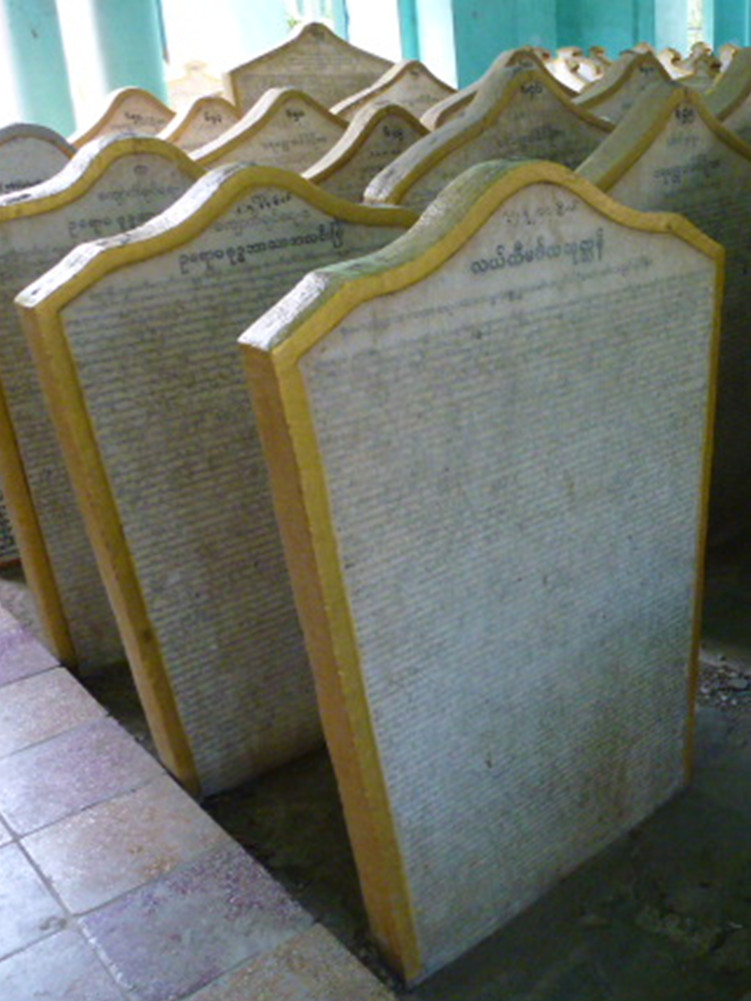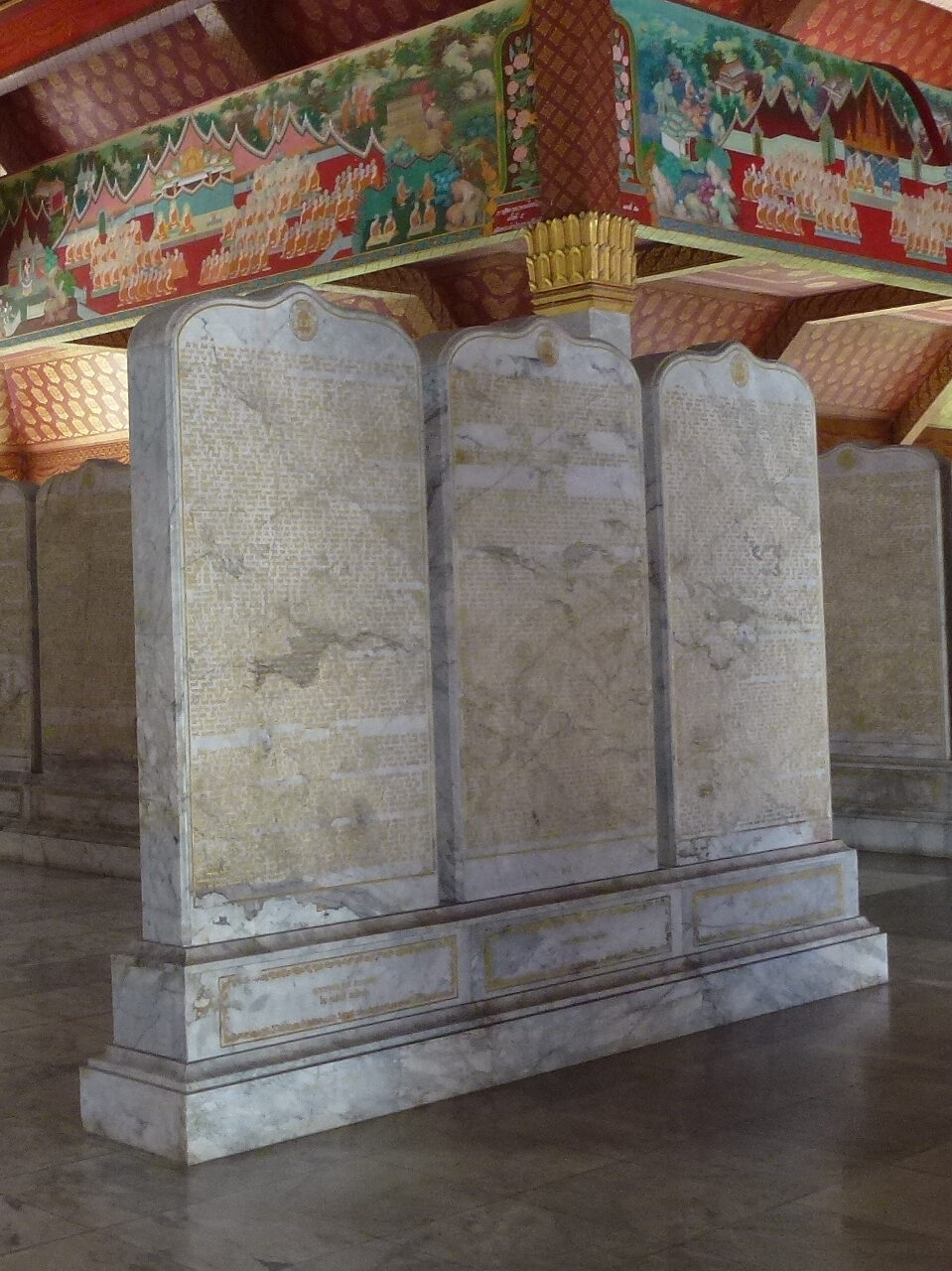Kuthodaw Pagoda

Photo: Sarah Kenderdine & Ben Healley
King Mindon (reigned 1853–1878), Myanmar’s penultimate king, is often remembered today as a particularly devout patron of Buddhism. He founded Mandalay in 1857 and ordered the construction of some of the city’s earliest religious sites, including an ordination hall, a monastery, a library for religious texts and the Kuthodaw Pagoda (“Pagoda of Royal Merit”). This site, which can still be visited today, is famous for preserving an authorised mid-nineteenth century Myanmar recension of the Pali canon, the primary scriptures of Theravāda Buddhism.
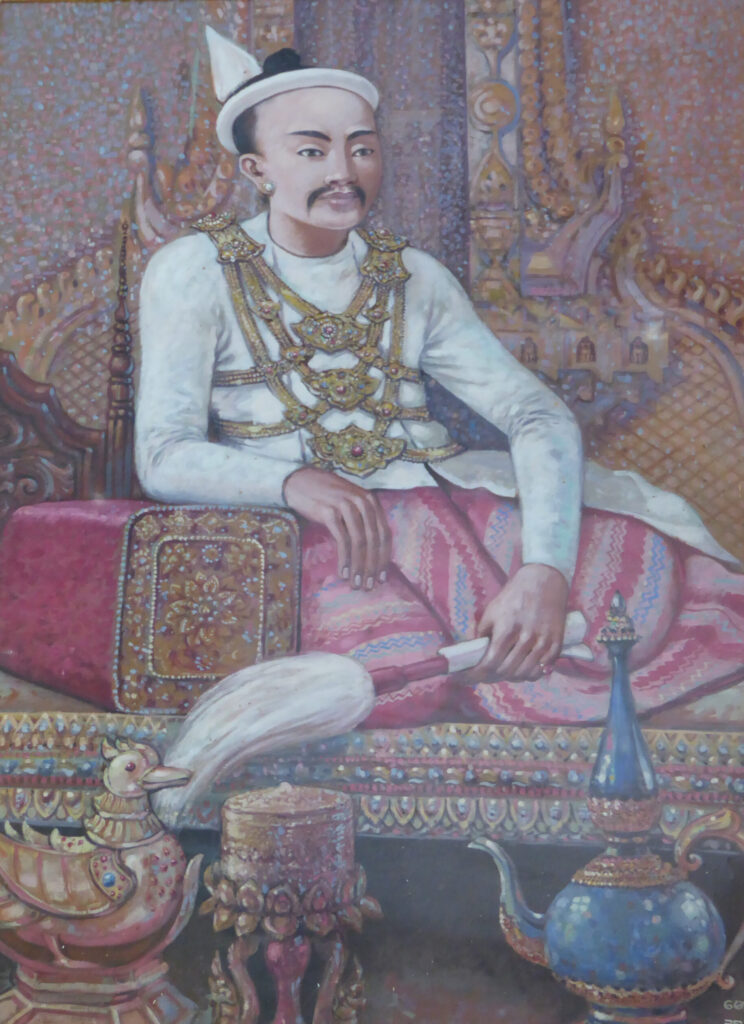
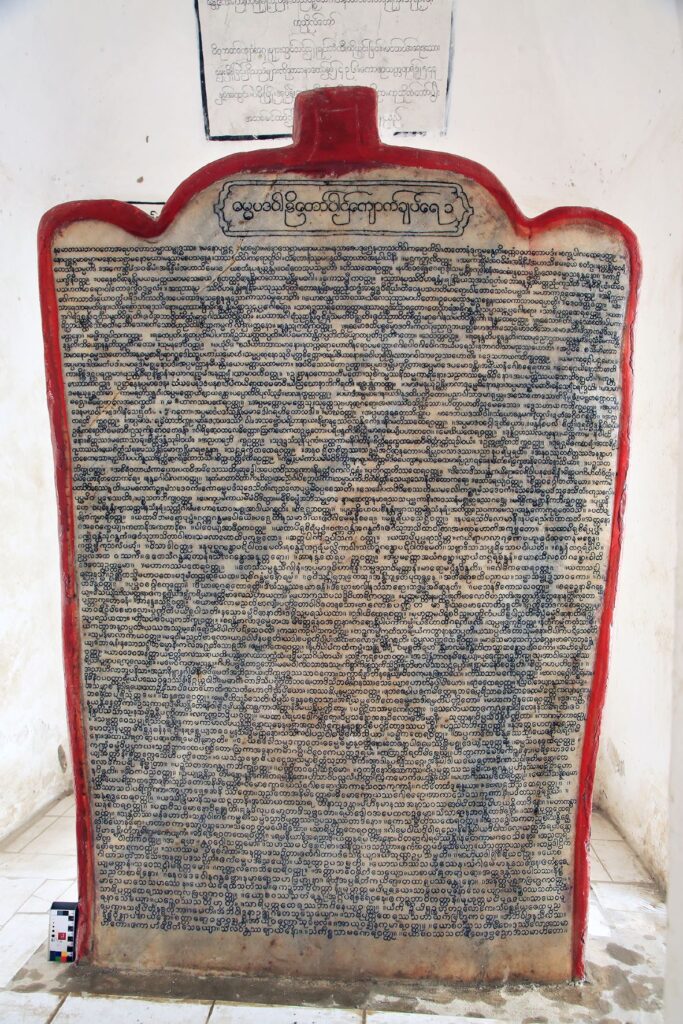
Unlike previous royally commissioned copies of the Pali canon, which were handwritten on palm leaves, this recension was also inscribed on stone. Spread over 5.2 hectares, the 729 marble stelae are arranged in seven concentric squares around the site’s central gilded pagoda. Each stela varies in size, though a typical one is approximately 1.3 metres high, a metre wide, has around 75 lines of inscribed text on each side and is housed in a separate open-sided mini-pagoda around 3 metres in height.
Some time after the Pali text was inscribed, four additional marble stelae were added to the site, meaning that the site has a total of 733 marble stelae. These Burmese language stelae have not yet been translated into English; however, they include descriptions of historical events relating to King Mindon and also list the contents of the Pali language stelae.
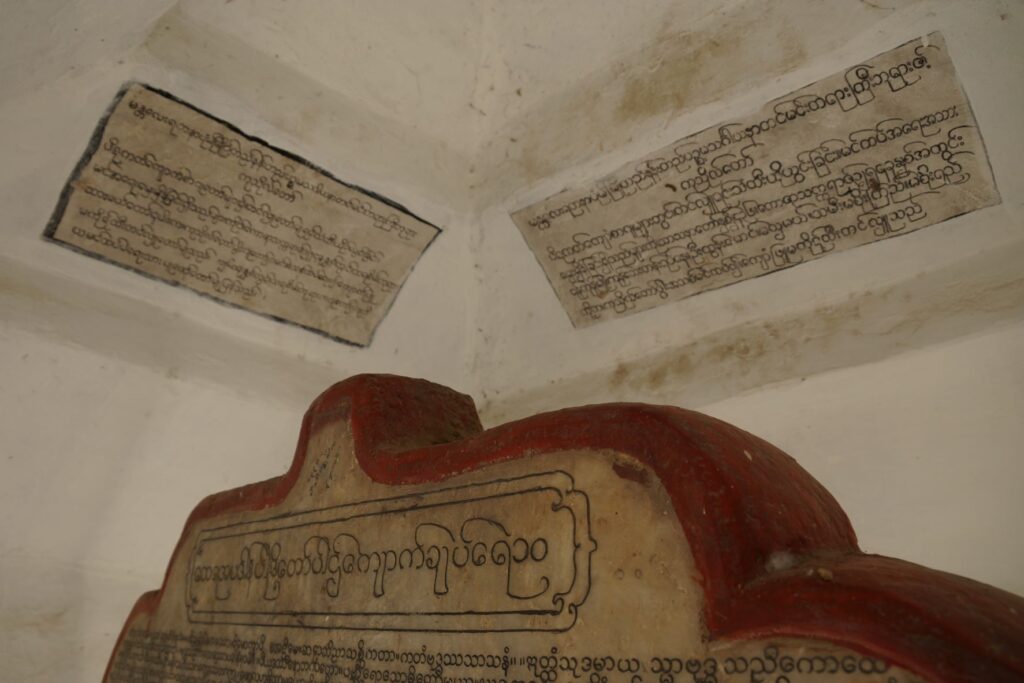
Additionally, the Kuthodaw Pagoda has an unusually rich collection of donative inscriptions, often small plaques written in Burmese attached to the outside of the mini-pagodas which house the marble stelae, or placed high on the inner walls. This collection, most likely numbering in the thousands, demonstrate the ongoing religious patronage and religious aspirations of generations of local Buddhists, and attest to the important role the site has played in the lives of those who patronized the site.
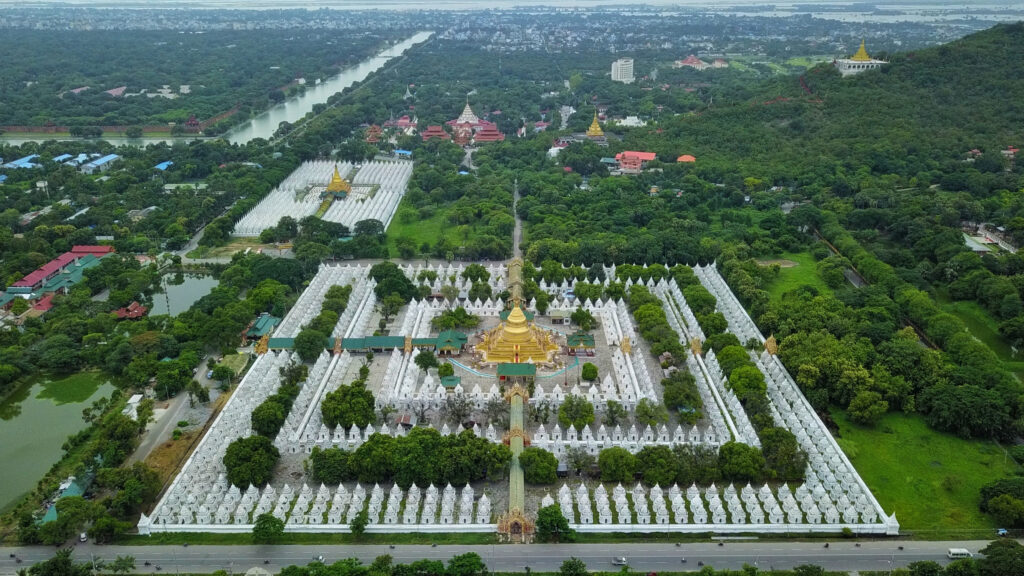
Throughout the history of the site, various renovations and additions have been made. In the early 1890s, two avenues of starflower trees (Mimusops elengi) were planted. Some of these trees are still alive today and provide some welcome shade during the warmer months. On several occasions, the inscribed text on a stela has been reinked with a mixture of shellac and carbon black, though more recently with black enamel paint. Additionally, the metal umbrellas on top of the mini-pagodas have been replaced, the floors of the mini-pagodas have been tiled and some of the large wooden gates to the site have been replaced.
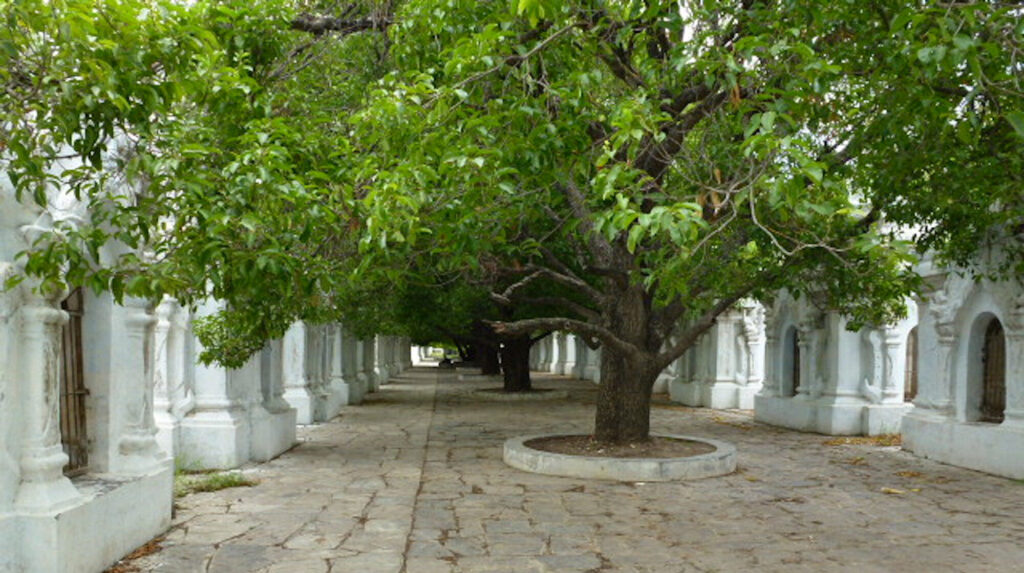
The Fifth Buddhist Council
The recension of the Pali canon inscribed on the Kuthodaw Pagoda stelae is part of a broader effort by King Mindon to preserve Buddhist texts. This project began in 1857 when the king commissioned the copying of a new set of the Pali canon onto palm leaves, one copy of which is now housed at the British Library. This edited text was then used as an exemplar to inscribe the Kuthodaw Pagoda stelae between 1860 and 1868. Following this, King Mindon revived the early Theravāda tradition of holding a council (saṅgīti) for the recitation and verification of the words of the Buddha. The “Fifth Buddhist Council” was held in 1871, reportedly involving 2,400 monks orally reciting the entire canon for 150 days.

The Kuthodaw Pagoda as model for other sites in Asia
King Mindon’s carving of the entire Pali canon on marble stelae was unprecedented in the Theravāda Buddhist world and it subsequently became the inspiration for further stone inscriptions of Pali literature at several sites in Myanmar and abroad. The first example of this was the Sandamuni Pagoda, directly adjacent to the Kuthodaw Pagoda, which preserves the Pali commentaries and sub-commentaries carved on 1774 marble stelae at the instigation of the hermit U Khanti in 1913. Pali and Burmese writings of the famous monk Ledi Sayadaw, who participated in the Fifth Buddhist Council, have been inscribed on 550 marble stelae at his monastery at Monywa, Myanmar. The entire Pali canon was inscribed in Thai script on 1418 marble stelae at Phutthamonthon Park in Thailand, Nakhon Pathom Province, and was completed in 1957. A Karen language translation of the Pali canon is currently being constructed in lower Myanmar. At Devram Vihāra in Colombo, Sri Lanka, a similar project has been underway since 2005 and has thus far completed inscriptions for a substantial portion of the Suttapiṭaka of the Pali canon. These sites demonstrate the strong influence the Kuthodaw Pagoda site has had, and continues to have, on the Theravāda Buddhist world.
Printed editions of Pali texts in Myanmar
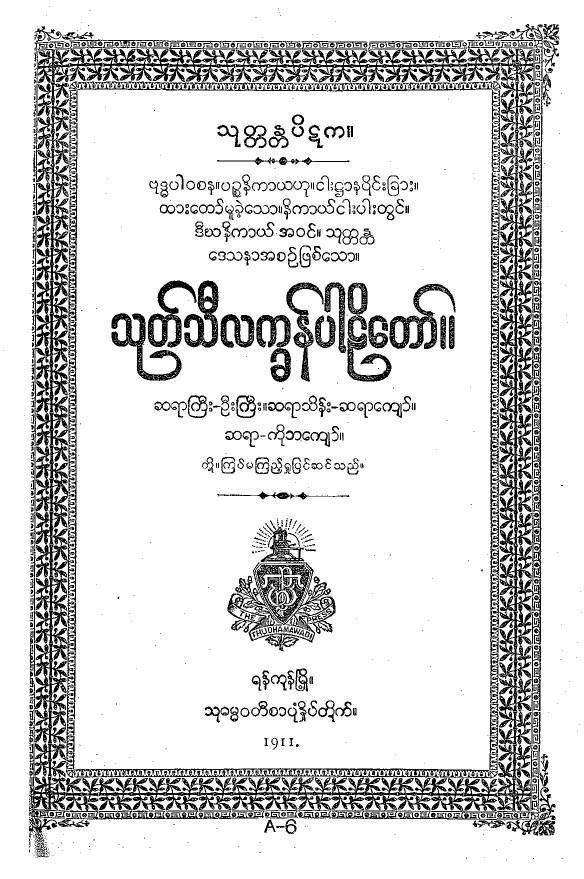
The earliest printed editions of Pali texts in Myanmar used the Kuthodaw Pagoda recension as their exemplar, further underscoring the importance of this recension. As far as we know, the first complete printing of the Pali canon in Myanmar was published by the Hanthawaddy Press in Yangon, beginning in 1893. This book series printed the Kuthodaw Pagoda recension, though with occasional minor textual changes. In order to emphasize its reliance on the Kuthodaw Pagoda recension, from 1900 the title pages of the Hanthawaddy Press series explicitly refer to the Mandalay stelae, using wording that is strikingly similar to the sentence found at the top of the verso side of each stela. Following this example, other publishing companies produced editions of Pali texts based upon the Kuthodaw Pagoda recension, e.g. Thudhamawadi, Ratanādīpa and Zabu Meit Swe Presses. Held at Yangon, Myanmar, in 1954–1956, the “Sixth Buddhist Council” produced a newly edited version of the Pali canon which also had the Kuthodaw Pagoda recension as its basis. The digital versions of the Pali canon most widely used today (e.g. Vipassana Research Institute, Digital Pāli Reader, SuttaCentral, etc.) are transcriptions of this printed series, meaning that they are also related to the Kuthodaw Pagoda recension.
UNESCO status
The international significance of the Kuthodaw Pagoda was publicly recognised in 2013 with acceptance of the site on UNESCO’s “Memory of the World” register, which aims to safeguard the documentary heritage of humanity by preservation, increased universal access and worldwide awareness of its existence and significance.
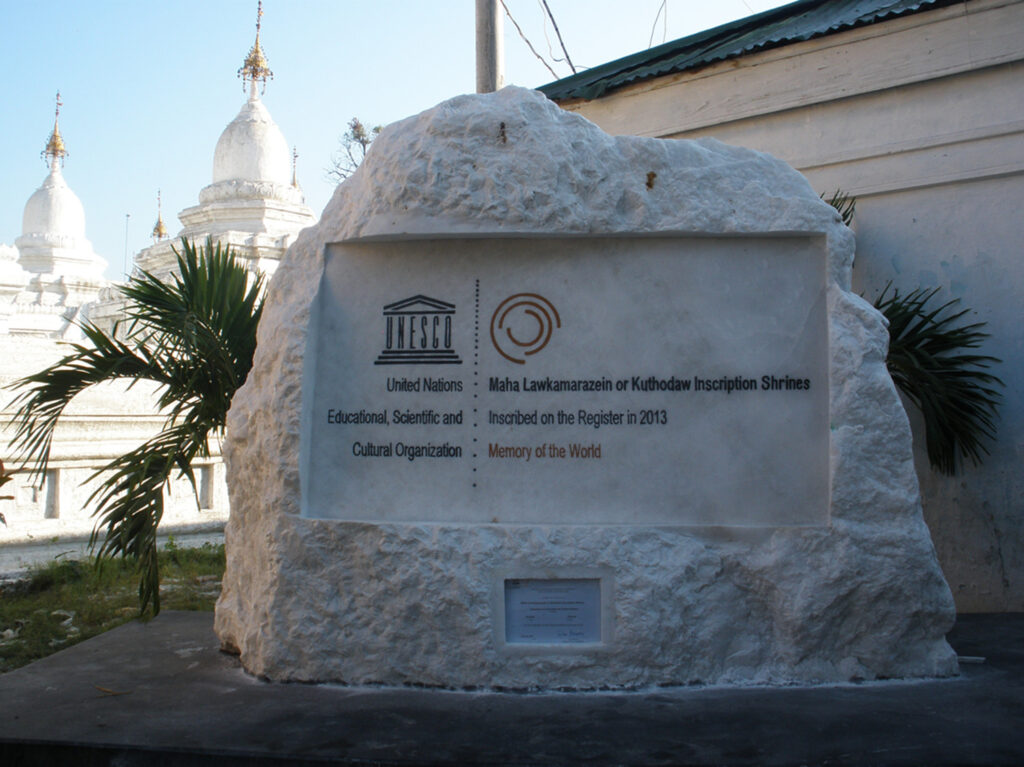
Collection Publications
Wiles, Royce, Chris Clark, Tamara Ditrich and Mark Allon. 2021. “The Pāli Tipiṭaka Recension Carved on the Kuthodaw Pagoda Stelae and Its Relation to Other Burmese Versions”. Journal of the Pali Text Society 34: 155–226.
Reade, Wendy. 2018. “The Kuthodaw Pagoda, Myanmar: Collaborative Conservation of a UNESCO Memory of the World Site”. AICCM Bulletin (journal of the Australian Institute for the Conservation of Cultural Materials) 39(1): 55–64.
Allon, Mark, Wendy Reade, Chris Clark, Ian McCrabb, Tamara Ditrich, Royce Wiles and Bob Hudson. 2016. “The Kuthodaw Pagoda Marble-Stelae Inscriptions, Mandalay, Myanmar: Conservation, Photographing, and Study of a Neglected Recension of the Pali Buddhist Canon”. Bulletin of Chuo Academic Research Institute (Chuo Gakujutsu Kenkyūjo Kiyō) 45: 222–249.
Allon, Mark. 2016. “‘The World’s Biggest Book’: The Kuthodaw Pagoda Marble-Stelae Inscriptions, Mandalay, Myanmar”. TAASA Review (quarterly journal of The Asian Arts Society of Australia) 25(4): 7–8.
Reade, Wendy. 2016. “Preserving the Kuthodaw Pagoda Complex, Myanmar: Collaborative Conservation of the ‘World’s Biggest Book’”. TAASA Review (quarterly journal of The Asian Arts Society of Australia) 25(4): 9–11.
Allon, Mark. 2015. “Progress Report for Kuthodaw Pagoda Project (Mandalay, Myanmar) for Work Undertaken to September 2015: Presented to Chuo Academic Research Institute of Rissho Kosei-Kai”. Bulletin of Chuo Academic Research Institute (Chuo Gakujutsu Kenkyūjo Kiyō) 44: 188–199.
Allon, Mark. 2014. “The Conservation and Photographing of the Kuthodaw Pagoda Marble-Stelae Recension of the Pali Buddhist Canon in Mandalay, Myanmar”. Bulletin of Chuo Academic Research Institute (Chuo Gakujutsu Kenkyūjo Kiyō) 43: 186–193.
[Presentation] Allon, Mark. “Research on the Kuthodaw Pagoda marble-stelae recension of the Pali canon in Mandalay, Myanmar”. Rainy Season Research Series, King’s College London, 23 October 2020. See YouTube recording.
[Presentation] Clark, Chris. “On the making of the Kuthodaw Pagoda: A monumental inscriptional site of Buddhist literature”, Religious Studies Seminar, University of Edinburgh, 16 October 2019.
[Presentation] Clark, Chris. “Recent digital projects linking Buddhist texts and images”, Indian Buddhist Narrative: Text and Image Symposium, University of Edinburgh, 6–7 September 2019.
[Presentation] Allon, Mark. “New research on the Kuthodaw Pagoda in Mandalay, Myanmar, and its marble-stelae recension of the Pali Buddhist Canon”. Asian Studies Association of Australia Conference, University of Sydney, 3–5 July 2018.
[Presentation] Wiles, Royce and Tamara Ditrich. “Research on the Kuthodaw Pagoda marble-stelae recension of the Pāli canon in Mandalay, Myanmar”. XVIIIth Congress of the International Association of Buddhist Studies, University of Toronto, 20–25 August 2017.
[Presentation] Allon, Mark. “Final report on the Conservation and Photographing of the Kuthodaw Pagoda Marble-stelae Recension of the Pali Buddhist Canon in Mandalay, Myanmar”. Chuo Academic Research Institute, Tokyo, 8 December 2016.
[Presentation] Allon, Mark, Tamara Ditrich, Chris Clark, Ian McCrabb and Wendy Reade. “World’s Biggest Book: The Conservation, Photographing, and Study of the Kuthodaw Pagoda Marble-Stelae Recension of the Pali Buddhist Canon in Mandalay, Myanmar” Australasian Association of Buddhist Studies Seminar, University of Sydney, Sydney, 27 October 2016.
[Presentation] Clark, Chris. “The conservation, photographing and study of the Kuthodaw Pagoda inscriptions of Mandalay”. Asian Studies Association of Australia Conference, Australian National University, Canberra, 5–7 July 2016.
[Presentation] Allon, Mark. “Second year report on the Conservation and Photographing of the Kuthodaw Pagoda Marble-stelae Recension of the Pali Buddhist Canon in Mandalay, Myanmar”. Chuo Academic Research Institute, Tokyo, 22 December 2015.
[Presentation] Reade, Wendy, Elizabeth Carter, and Mark Allon. “Identification of the Coating on the Marble Buddhist Inscriptions of the Kuthodaw Pagoda Complex, Mandalay, Myanmar (UNESCO Memory of the World Register)”. 11th Australian Conference on Vibrational Spectroscopy (ACOVS11) and the 5th Asian Spectroscopy Conference (ASC5), University of Sydney, 29 September – 2 October 2015.
[Presentation] Allon, Mark and Wendy Reade. “The Conservation, Photographing, and Study of the Kuthodaw Pagoda Marble-stelae Recension of the Pali Buddhist Canon in Mandalay, Myanmar”. Australia-Myanmar Institute Conference, Yangon University, Yangon, 10–13 July 2015.
[Presentation] Allon, Mark. “The Conservation and Photographing of the Kuthodaw Pagoda Marble-stelae Recension of the Pali Buddhist Canon in Mandalay, Myanmar”. Chuo Academic Research Institute, Tokyo, 8 December 2014.


